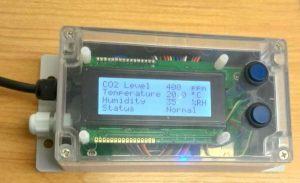CO2 Monitoring is mandatory in many workplaces and it affects two of my clients directly in Barrel Halls where wine is stored and aged in temperature and environmentally controlled areas. The table below shows the affects of various concentrations in the air.
| 250-350ppm | Normal background concentration in outdoor ambient air |
| 350-1,000ppm | Concentrations typical of occupied indoor spaces with good air exchange |
| 1,000-2,000ppm | Complaints of drowsiness and poor air. |
| 2,000-5,000 ppm | Headaches, sleepiness and stagnant, stale, stuffy air. Poor concentration, loss of attention, increased heart rate and slight nausea may also be present. |
| 5,000 | Workplace exposure limit (as 8-hour TWA) in most jurisdictions. |
| >40,000 ppm | Exposure may lead to serious oxygen deprivation resulting in permanent brain damage, coma, even death. |
The project described below uses a MH-Z16 or MH-Z19 CO2 sensor and a DHT-22 (or DHT-11 if less accuracy is required) to measure the Temperature and Humidity. It has a 4 line by 20 character LCD Display to show the current readings and status, a warning alarm and two relays which can be triggered on a low CO2 (Generally above 1000 ppm) normally to switch on an extractor fan and a high level (4000 ppm) which will trigger a warning device such as an external alarm. There are two models I used the 0 to 5000 ppm device here but the code will be the same for the 0 to 10000 ppm model.
Warning: The system is mains powered (100VAC – 240VAC) so if you are replicating the project you should be very careful when wiring up and enclosing the board to ensure it meets all safety guidelines, and if it is going into a public space or factory environment it will need to be installed and tested by a qualified electrician. The PCB is designed for a standard industrial 158 x 90 x 65 mm Plastic Enclosure.
Circuit Description
The MH-z19 is a self contained sensor powered from 5V which has its own internal processor and outputs the CO2 level as either a pulse width modulated signal or in a serial UART data format. The datasheet is not very detailed but has enough information to use it. I still have a lot of PIC18F24K22 chips lying about from Wine Technology Marlborough’s MLP project and as this has 2 UARTS I decided to use the serial port. The PIC is a little overkill but two UARTS does mean we have a spare serial port that can be used in case the builder wants to output the air quality data to another system.
A HD44780 compatible 4 line x 20 character display (2004) was chosen so I could fit all the information on without being too cramped. The interface to the PIC is via 4 data lines not 8 as I was initially going to use the extra ports for another purpose. The only difference between the 4-bit and 8-bit interface is a single initialization bit and the need to then send two writes to the device not one. (less soldering is also always good if you are building it without a PCB) The LCD is mounted on the transparent front of the enclosure and connected by flying leads to the PCB
Read more: CO2, temperature and humidity monitor

